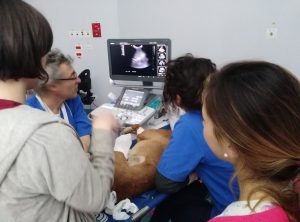Evaluation of hemostatic and fibrinolytic markers in dogs with ascites attributable to right-sided congestive heart failure
Zoia A1, Augusto M, Drigo M, Caldin M.
Evaluation of hemostatic and fibrinolytic markers in dogs with ascites attributable to right-sided congestive heart failure
J Am Vet Med Assoc. 2012 Nov 15;241(10):1336-43. doi: 10.2460/javma.241.10.1336
Scarica la pubblicazione
Abstract
OBJECTIVE: To determine whether dogs with ascites secondary to right-sided congestive heart failure (CHF) have bleeding disorders associated with hypofibrinogenemia and discordant plasma fibrin-fibrinogen degradation products (FDPs) and D-dimer assay results (ie, a circulating concentration of FDPs higher than the reference range and a circulating concentration of D-dimer within the reference range).
DESIGN: Retrospective case-control study.
ANIMALS: 80 client-owned dogs.
PROCEDURES: Dogs with ascites secondary to right-sided CHF (group 1; n = 20), unhealthy dogs without cardiac disease (group 2; 40), and dogs with left-sided CHF (group 3; 20) were included in the study. Urine bile acids-to-creatinine concentration ratios were calculated as a marker of liver function. Differences among groups regarding coagulation profile analysis results and prevalence of discordant FDPs and D-dimer assay results were determined.
RESULTS: No significant differences were detected among the 3 groups regarding urine bile acids-to-creatinine concentration ratios. Plasma fibrinogen concentration was significantly lower for group 1 versus groups 2 or 3. Prevalence of discordant FDPs and D-dimer assay results was significantly higher for group 1 versus groups 2 or 3. Eighteen group 1 dogs had discordant FDPs and D-dimer assay results. Ten of these dogs had concurrent hypofibrinogenemia, 2 of which had clinical signs of bleeding. Only 10 dogs in groups 2 or 3 had discordant FDPs and D-dimer assay results; none of these dogs had hypofibrinogenemia or clinical signs of bleeding.
CONCLUSIONS AND CLINICAL RELEVANCE: Dogs with right-sided CHF and ascites may be at increased risk for primary hyperfibrinogenolysis (ie, hypofibrinogenemia and discordant FDPs and D-dimer assay results)






 Il Direttore Sanitario Dott. Marco Caldin
Il Direttore Sanitario Dott. Marco Caldin